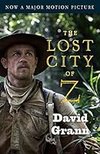
The Lost City of Z

Evidence showed that the Peruvian Amazon Company had committed virtual genocide in attempting to pacify and enslave the native population: it castrated and beheaded Indians, poured gasoline on them and lit them afire, crucified them upside down, beat them, mutilated them, starved them, drowned them, and fed them to dogs. The company’s henchmen also
... See moreDavid Grann • The Lost City of Z
The explorers paddled past the Ricardo Franco Hills, eerie sandstone plateaus that rose three thousand feet. “Time and the foot of man had not touched those summits,” Fawcett wrote. “They stood like a lost world, forested to their tops, and the imagination could picture the last vestiges of an age long vanished.” (Conan Doyle reportedly based the
... See moreDavid Grann • The Lost City of Z
“Deep down inside me a tiny voice was calling,” Fawcett said. “At first scarcely audible, it persisted until I could no longer ignore it. It was the voice of the wild places, and I knew that it was now part of me for ever.” He added, “Inexplicably—amazingly—I knew I loved that hell. Its fiendish grasp had captured me, and I wanted to see it again.”
David Grann • The Lost City of Z
The endeavor, from the time the ancient Greeks laid out the main principles of sophisticated cartography, took hundreds of years, cost millions of dollars, and claimed thousands of lives, and, when it was all but over, the achievement was so overwhelming that few could recall what the world looked like before, or how the feat had been accomplished.
David Grann • The Lost City of Z
“Explorers are not, perhaps, the most promising people with whom to build a society. Indeed, some might say that explorers become explorers precisely because they have a streak of unsociability and a need to remove themselves at regular intervals as far as possible from their fellow men.”
David Grann • The Lost City of Z
While most of my articles seem unrelated, they typically have one common thread: obsession. They are about ordinary people driven to do extraordinary things—things that most of us would never dare—who get some germ of an idea in their heads that metastasizes until it consumes them.
David Grann • The Lost City of Z
“Jararaca” his father said. It was a pit viper, one of the most venomous snakes in the Americas. (A jararaca bite will cause a person to bleed from the eyes and become, as a biologist put it, “a corpse piece by piece.”)
David Grann • The Lost City of Z
Christopher Columbus had first reported seeing Indians bouncing a ball made from the strange, sticky substance that bled from tropical trees, but it wasn’t until 1896, when B. F. Goodrich manufactured the first automobile tires in the United States, that rubber madness consumed the Amazon, which held a virtual monopoly on the highest-quality latex.
David Grann • The Lost City of Z
Fawcett was taught not just how to survey but how to see—to record and classify everything around him, in what the Greeks called an autopsis.